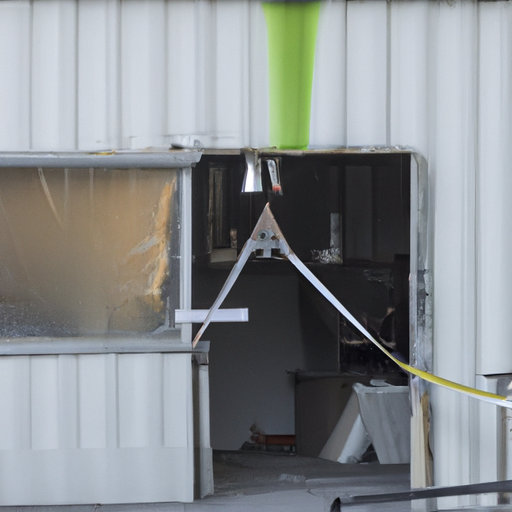
Understanding the Technology Behind Blast Proof Doors
This blog post delves into the intricate technology that fortifies blast proof doors, offering a comprehensive understanding of their functionality, design, and significance in providing security. It explores the engineering principles behind their robustness, the materials used in their construction, and the rigorous testing processes they undergo to ensure their efficacy.
1. The Blueprint: How are Blast Proof Doors Designed?
Blast proof doors are meticulously engineered structures that play a crucial role in safeguarding lives and property during high-risk situations. The design process of these doors involves a comprehensive approach that considers various factors to ensure optimal performance.
Firstly, Blast proof doors are designed with a focus on structural integrity. This involves creating a robust framework that can withstand the immense pressure generated by an explosion. Engineers carefully analyze the force dynamics of blasts to determine the most effective design elements, such as reinforcements and impact-resistant materials.
Secondly, Blast proof doors are meticulously crafted to provide a tight seal against the surrounding structure. This seal is essential for containing the blast pressure and preventing the entry of debris and harmful substances into the protected area. Special attention is given to the door's joints, hinges, and locking mechanisms to ensure a secure and airtight closure.
Finally, Blast proof doors are designed with consideration for functionality and accessibility. While prioritizing strength and security, designers also aim to maintain ease of use for occupants. Factors such as door size, weight, and opening mechanism are carefully calibrated to ensure smooth operation during emergency situations. Additionally, features like panic hardware and emergency release systems are integrated to facilitate quick evacuation when needed.

1. Illustration of a blast proof door detailing its multiple layers and engineering design.
2. "Strength is in the materials": What are Blast Proof Doors Made of?
Blast proof doors are constructed using a combination of high-strength materials carefully selected to withstand the extreme forces generated by explosions. One of the primary materials used in the construction of Blast proof doors is steel, known for its exceptional durability and impact resistance. Steel provides the structural backbone of the door, offering crucial support and protection against blast pressure.
In addition to steel, Blast proof doors often incorporate specialized ballistic materials such as Kevlar and bullet-resistant glass to enhance their protective capabilities. These materials are designed to absorb and dissipate energy from blasts, reducing the impact on the door and the surrounding structure.
Furthermore, Blast proof doors may feature layers of reinforced concrete or composite materials to provide an extra level of defense against blasts. These materials are strategically integrated into the door's design to enhance its strength and resilience, making it more effective in withstanding high-pressure events.
3. Testing the Titans: How are Blast Proof Doors Tested?
Blast proof doors undergo rigorous testing procedures to ensure their ability to withstand the immense forces generated by explosions. One common test method is the blast resistance test, where doors are subjected to simulated blast pressures to evaluate their structural integrity and performance. During these tests, doors are exposed to varying levels of pressure to assess their resistance to shock waves and debris impact.
Additionally, Blast proof doors are often tested for their ability to maintain structural stability and functionality after a blast event. This includes assessing factors such as deformation, fragmentation, and overall effectiveness in containing blast effects. Engineers carefully analyze the test results to identify any weaknesses in the door's design and make necessary improvements to enhance its resilience.

3. Photo sequence showing a blast proof door undergoing rigorous testing procedures.
4. Can we trust Blast Proof Doors? Understanding Their Role in Security
Blast proof doors play a crucial role in enhancing security measures for buildings and facilities in high-risk environments. Their ability to withstand blast forces and protect occupants from potential harm is a testament to their importance in safeguarding lives and property. By providing a barrier against explosive threats, Blast proof doors serve as a critical line of defense in mitigating the impact of blasts and ensuring the safety of individuals within a protected space.
In high-security settings such as government buildings, embassies, military installations, and critical infrastructure facilities, Blast proof doors are a fundamental component of overall security strategies. Their robust construction and advanced design features make them essential elements in fortifying buildings against potential terrorist attacks or accidental explosions. The trust placed in Blast proof doors stems from their proven track record in real-world scenarios where their effectiveness has been demonstrated in protecting lives and limiting damage.
Moreover, the reliability of Blast proof doors is further reinforced by adherence to stringent industry standards and regulations governing their design, manufacturing, and testing processes. Compliance with these standards ensures that Blast proof doors meet specific performance criteria and are capable of withstanding various blast scenarios. Building owners and security professionals can have confidence in the integrity of Blast proof doors knowing that they have been rigorously tested and certified to provide the necessary level of protection in high-pressure situations.
In conclusion, the technology behind blast proof doors is a testament to human ingenuity and our commitment to ensuring safety in the face of potential threats. Their design, materials, and testing all contribute to their effectiveness, serving as impenetrable shields between us and possible harm. Understanding their workmanship not only broadens our technical knowledge but also reinforces our appreciation for these marvels of engineering.


